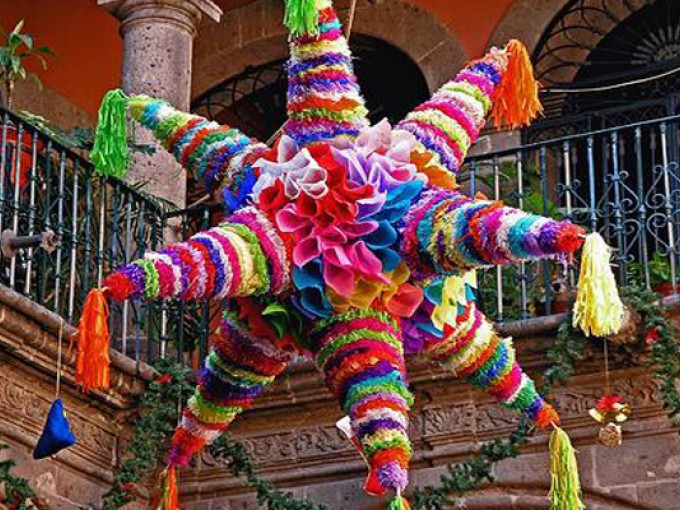
Fun Latin American Holiday Traditions – Get Into the Spirit
7 Latino Christmas Traditions
It’s that time of year. And while images of snow on decorated fir trees and rosy-cheeked carolers singing Jingle Bells may be traditional for many of us in the Northern Hemisphere, things are quite different in the South.
Many families worldwide celebrate December 25th, but Christmas traditions in many Latin American countries often begin long before that. And the range of traditions is quite remarkable.
So, we’re here to take you on a tour and get you in the holiday spirit. Grab a hot chocolate and get ready to learn about the holiday traditions of several Latin American countries.
1. Nochebuena in Argentina

Argentina celebrates Nochebuena in place of Christmas Eve on December 24th. At approximately 9:00 pm, the families gather around the table to laugh, toast, and delight themselves with a hearty dinner. Three tables are prepared for Nochebuena: the main table, the children’s table, and the dessert table.
Each person contributes to the Christmas dinner by bringing a special dish. This can make Christmas dinners in Argentina an interesting mix of flavors, often with a wide variety of desserts, sweets, and pies.
Argentineans are used to eating ham, empanadas, the irreplaceable traditional Christmas turkey, and the famous alfajor — a unique Argentinian dessert made with dulce de leche.
2. Las Posadas Christmas Ritual in Mexico
Mexico has strong religious roots, and Mexican Christmas traditions reflect this: Christmas in Mexico is a time to renew faith and respect traditions.
This is especially clear in Las Posadas, a common Christmas ritual. For nine nights in a row, various processions stage the story of Mary searching for shelter to give birth to Jesus. Walking through the streets of Mexico at this time, you’ll likely see children dressed as sheep and adults in prayer, carrying the images of Mary and Joseph.
Each night of the ritual ends with a feast that includes many traditional foods like hot punch, buñuelos (fried sweet dough), and the classic piñatas—large containers filled with sweets hung from the ceiling and then cracked open with sticks by children.

3. Día de las Velitas in Colombia
In Colombia, Día de las Velitas (“Day of the Little Candles”) is celebrated on December 7th and marks the beginning of the Christmas festivities. Houses and streets are decorated with many lights, candles, and lanterns. In many places, there are also large fireworks displays. Colombians also gather to dance and eat traditional foods such as buñuelos and empanadas.
Día de las Velitas is celebrated on the eve of the Immaculate Conception, which occurs on December 8th and is a national holiday in Colombia. The day is dedicated to celebrating the Virgin Mary.
In the nine days between December 16 and Christmas Eve, called las novenas, family, friends, and neighbors gather to pray. The main Christmas meal, Cena de Navidad, is eaten on Christmas Eve.
4. La Parranda Christmas Caroling in Puerto Rico
Puerto Rico is said to have one of the longest Christmas festivities in the world. They begin after Thanksgiving in November and end midway through January.
One of the most famous Christmas rituals is la Parranda, the Puerto Rican version of caroling. Parrandas are groups of people (parranderos) who visit their friends and neighbors with music (aguinaldos) throughout the night. It’s called Asalto navideño, or “Christmas assault,” because it’s intended to be a surprise.
When the surprised friend hears the music, they open the door and let the parranderos enter to continue singing inside the house. These friends eventually join the parranderos and go to the next house.
Parranderos continue to visit their friends and neighbors for hours, and more and more people join the party. The parranderos usually visit accompanied by homemade coquito, the Porteño version of eggnog.
5. Día de la Familia in Uruguay
Like many of its neighbors, Uruguay has historically been a Catholic country since colonization by the Spanish. However, unlike the surrounding countries, Uruguay has recently become quite secular, reflected in the less religious Christmas celebrations.
For example, Christmas is officially known as Día de la Familia (“Family Day”) in Uruguay, although many Uruguayans continue to call it Navidad (“Christmas”).
Uruguayans celebrate Christmas with their families. Like their traditions, their big meal often feels heavily influenced by Italy and Spain—panettone and turrón are both traditional features. A traditional roast turkey with provolone cheese and roasted vegetables often includes morrón vermelho (red bell pepper) and papa doce (sweet potato).
You’ll also find Uruguayans serving a traditional holiday drink called Medio y Medio (“half and half”), a mixture of sparkling sweet and dry white wine.
6. Religious Christmas Traditions in Paraguay
Unlike Uruguay, Paraguay’s Christmas traditions are much more religious, focused squarely on the birth and teachings of Jesus Christ.
Families put up nativity scenes with elements of nature and offerings for the baby Jesus, including many types of fruit: watermelons, melons, pineapple, and coconut. Floral arrangements decorate churches, parks, and city squares and complement other Christmas decorations like fairy lights.
Christmas dinner will almost always include a traditional Paraguayan soup and chipa guasú, a cake made from corn flour. You’ll also find a variety of meats and salads and the customary drink clericó, which is similar to sangria.
Christmas celebrations don’t end on the 25th—they last until January 6th, when the feast of the Epiphany takes place. This feast often features an appearance of the Three Wise Men, who bring presents to the children. The day before, on January 5th, children write letters to the wise men and request presents. They hide these letters in their shoes.
7. Réveillon in Brazil
In Brazil, Christmas is one of the most exciting holidays of the year, not only because it is a festive and special period for Christians—who make up the majority of Brazilians—but also because Christmas signals the beginning of summer vacation.
In mid-November, cities around the country decorate the streets, malls, squares, and houses with Christmas ornaments and lights. On December 24, families and friends gather to exchange gifts and celebrate with the traditional Christmas dinner, customarily served at midnight.
Peru (“turkey”) is a Christmas staple, as is roast beef, farofa, salpicão, chester, rabanada (a kind of fried bread with sugar), codfish dumplings (which originate in Portuguese cuisine), and panettone.
The next day, December 25, families gather again for Christmas lunch, eating leftovers from the previous night.
Brazil is also home to the massive New Year’s Eve party called Réveillon, with millions of people attending massive events. Perhaps the most famous is the Réveillon celebration in Rio de Janeiro, which features an impressive fireworks display and musical performances.
Happy Holidays!
Visiting Latin American countries during the holidays may delight you with the various customs, traditions, and ways to celebrate Christmas.
Besides discovering more about the culture of each country, knowing more about these customs can also be very useful to improve your learning and a new language, like Latin American Spanish or Brazilian Portuguese.
Pimsleur for the Holidays!
Enjoy a 7-day Free Trial and then only $19.95/month
The full Pimsleur course adds up to a $575 value. And that’s what many solo language learners, businesses, and government agencies have been happy to pay in the past… But that’s NOT what we want you to pay with this new offer. Instead, you can use Pimsleur and all its contents – from beginner to fluency – starting at just $14.95 monthly. You get immediate access to all lessons. You can cancel your monthly subscription anytime- no hassles or questions asked.
That’s not it, though…
For joining Pimsleur today, we also want to send you a free copy of Dr. Pimsleur’s e-book“How to Learn a Foreign Language.” This e-book sells on Amazon for $10.99… but it’s yours today FREE! Inside, Dr. Pimsleur shares in simple terms the results of his studies and how to learn languages the fastest way possible. It’s yours to keep even if you cancel during the 7-day free trial and don’t pay us anything! Consider it our gift to you for giving Pimsleur a try.
Get This New Deal
Risk-Free • Cancel Online Anytime

Share your experiences with Latin holiday traditions in the comments below, and have a Merry Christmas and a happy holiday season!